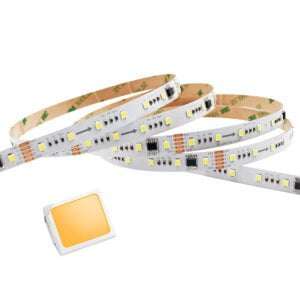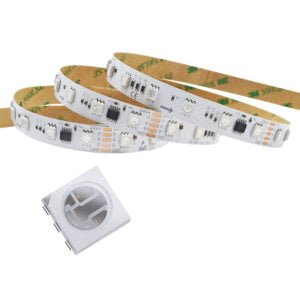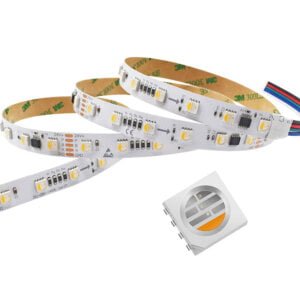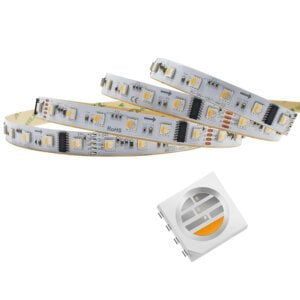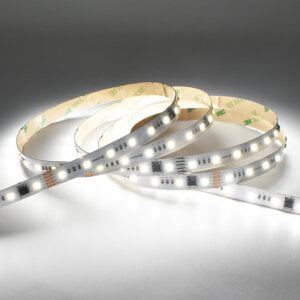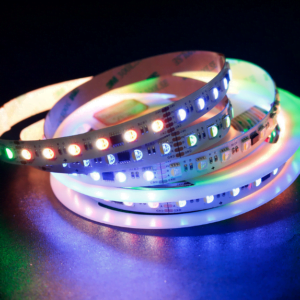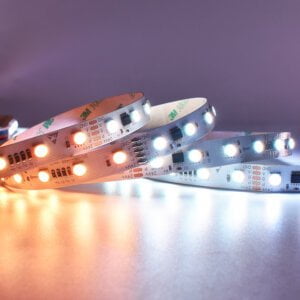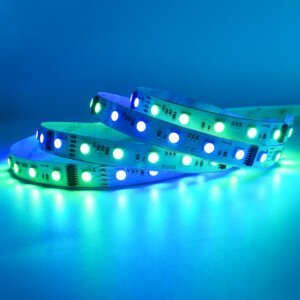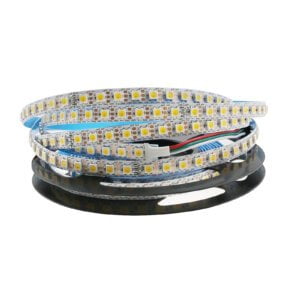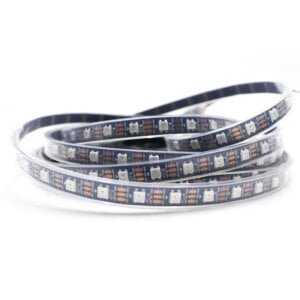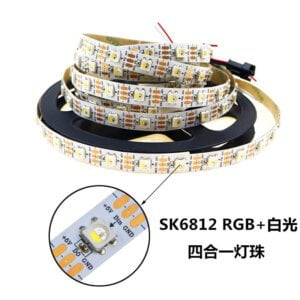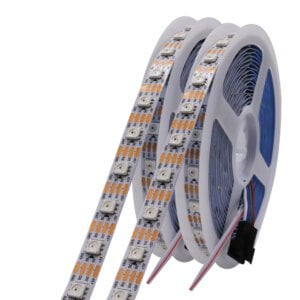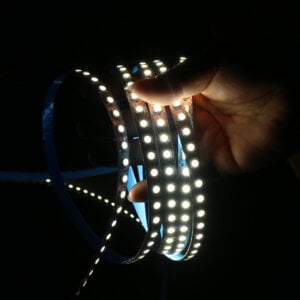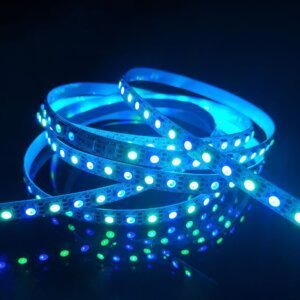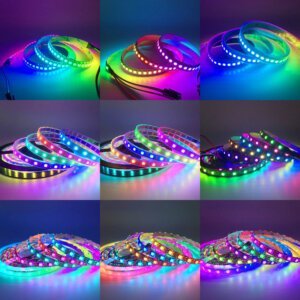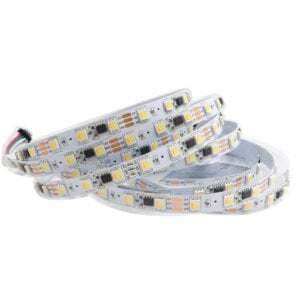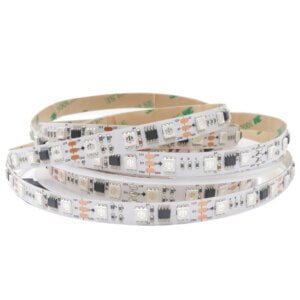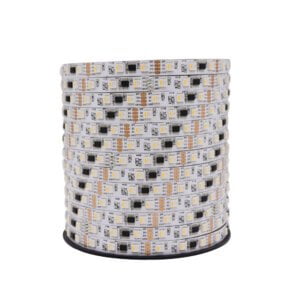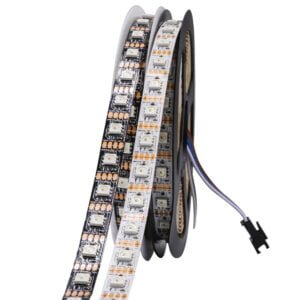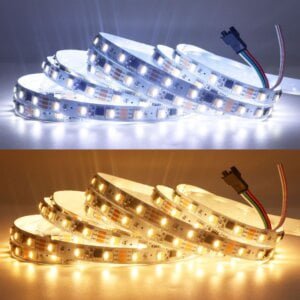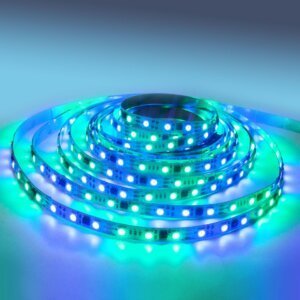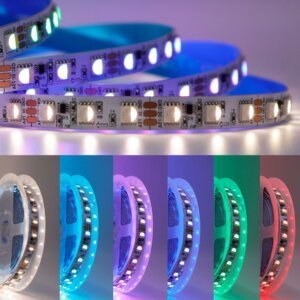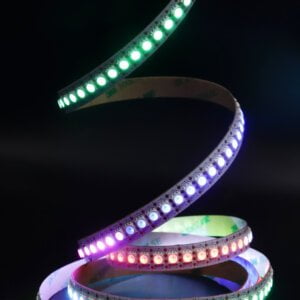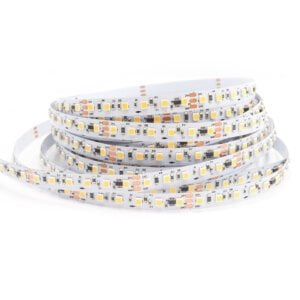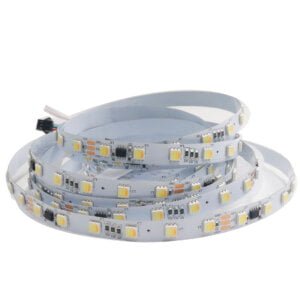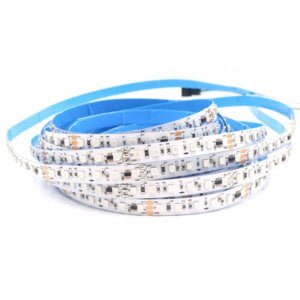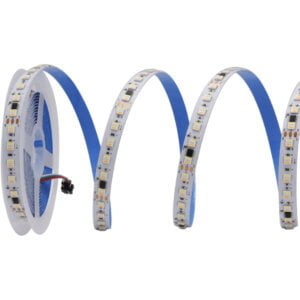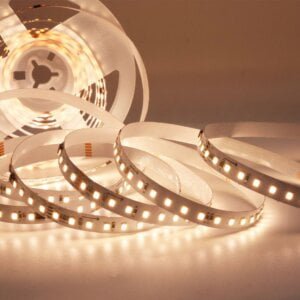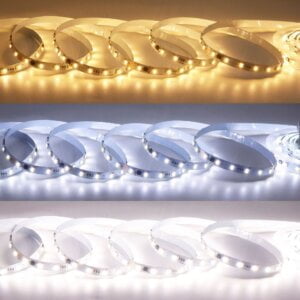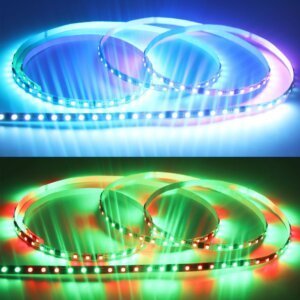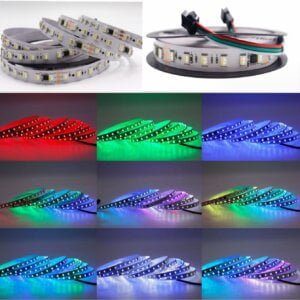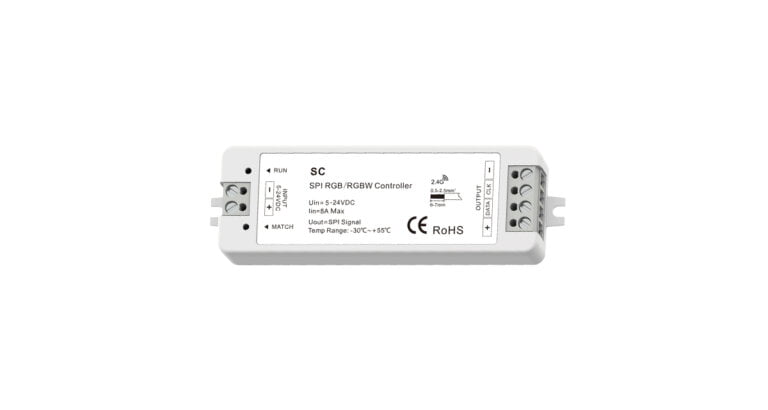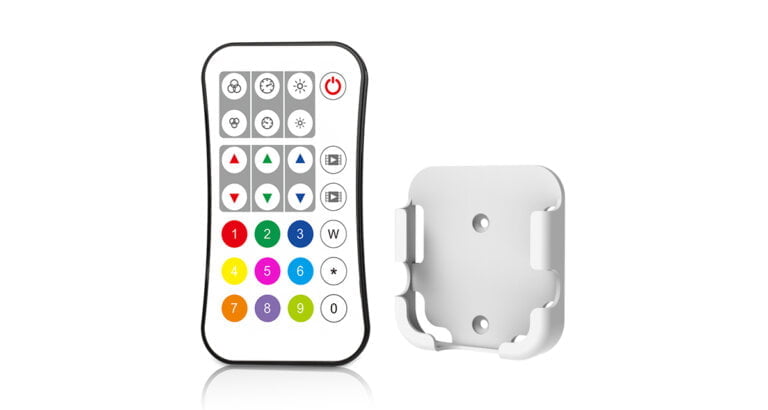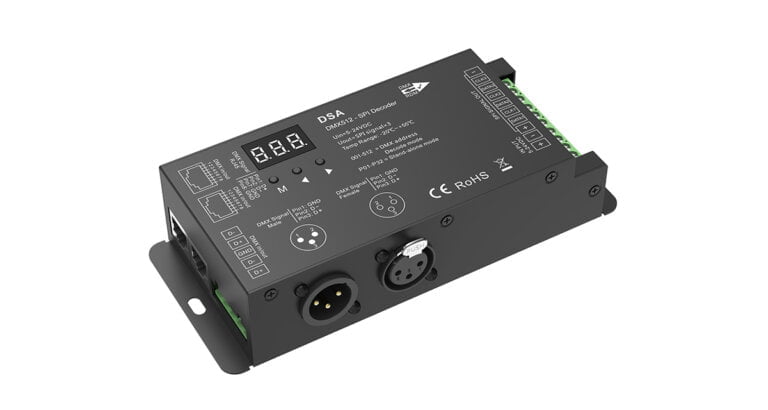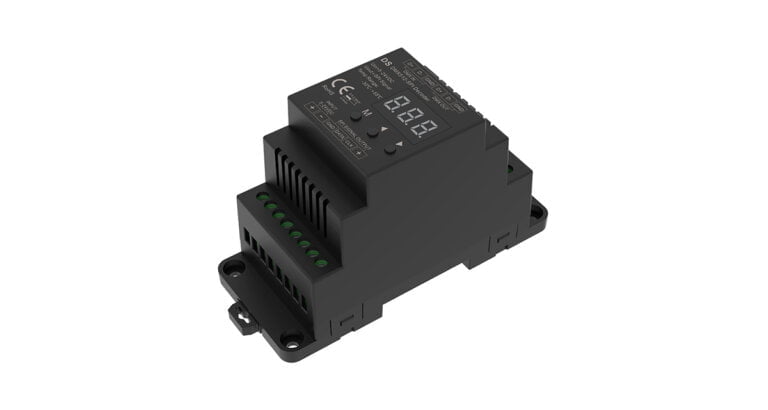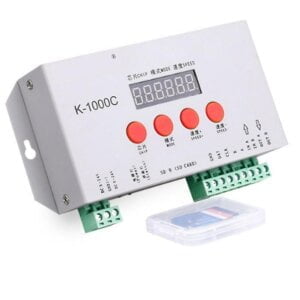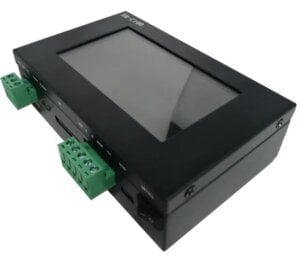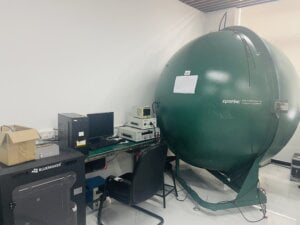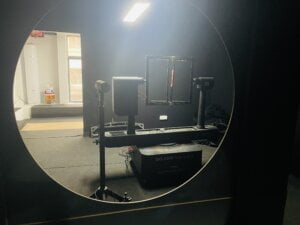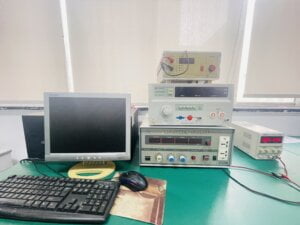Addressable RGB LED Strip
- RGB Led Strip are available.
- SMD/COB DMX512 and SPI are available.
- 5V, 12V and 24V are available.
- Customized Solution available.
- Quick response within 8hours.

Addressable LED Strip Supplier & Manufacturer
My Like Led stands as a prominent manufacturer in China specializing in individually addressable LED strips. Our offerings encompass a diverse range of programmable LED strips, including Pixel LED strips, Digital RGB LED strips, Running LED strips, Dream Color LED strips, RGB/RGBWIC LED strips, and Magic LED strips. Among our lineup, you will find renowned addressable LED strips like WS2811, WS2812, WS2812B, WS2813, WS2815B, WS2818, SK6812, UCS1903, and UCS2904, designed to provide optimal efficiency and value.
What is Addressable LED Strip?
The term “addressable LED strips” is used because these LED strips allow each individual LED to be uniquely addressed or assigned a specific command. Unlike traditional LED strips where all LEDs illuminate simultaneously, addressable LED strips enable control over each LED’s color and intensity. This level of control is achieved by assigning a distinct “address” to each LED through a microcontroller or integrated circuit.
By using digital communication protocols, such as WS2812, WS2813, or APA102, data is transmitted along the strip to address each LED individually. This data includes information about the desired color, brightness, and any animations or effects. As a result, the term “addressable” reflects the capability of targeting and controlling each LED independently, allowing for a wide range of dynamic and customizable lighting effects, commonly seen in car and vehicle lighting applications.
Why Choose Individually Addressable LED Strips?
Data Transmission
Addressable LED strips rely on a communication protocol, such as WS2812B, WS2813, APA102, or SK6812, to transmit data from the controller to each individual LED. These protocols enable precise control over the color and brightness of each LED in the strip.
Controller and Software
To control addressable LED strips, you use a microcontroller, such as an Arduino or a specialized LED controller. The microcontroller sends commands to the individual LEDs based on your programming. Additionally, software tools and libraries are available to simplify the programming process and create various lighting effects.
Customizable Lighting Effects
With addressable LED strips, you can create a wide range of lighting effects that go beyond static illumination. Each LED can display a different color or intensity, allowing you to create animations, gradients, moving patterns, and more. This makes them highly suitable for decorative and artistic lighting projects.
Interactive Experiences
Individually addressable LED strips enable interactive experiences. Through sensors, switches, or programming, you can design lighting that responds to user input, motion, sound, or environmental changes.
Individual Control
Addressable LED strips consist of multiple individual LEDs, each equipped with its own microcontroller or integrated circuit. This microcontroller allows each LED to receive and process unique instructions for color and intensity.
Impressive Visual Impact
The ability to smoothly transition colors, create patterns, and generate visual effects results in a stunning visual impact that elevates your space or project to new levels.
Applications of Pixel LED Strip
Digital LED strips are a favorite among artists and creators for crafting immersive and interactive art installations. The ability to control each LED individually allows for the creation of stunning visual displays that respond to user interactions, motion, or environmental changes.
In concerts, theaters, and entertainment events, digital LED strips create captivating lighting effects that synchronize with music, performances, and ambiance changes, enhancing the overall experience for the audience.
Retail spaces use digital LED strips to showcase products with attention-grabbing lighting effects. The ability to program animations and color changes helps attract customers’ attention and enhance product visibility.
Digital LED strips are integrated into home automation systems to create dynamic lighting scenes. They can adjust brightness, color, and patterns based on the time of day, user preferences, or specific events.
Digital LED strips are incorporated into interactive exhibits, escape rooms, and themed attractions to provide users with engaging and memorable experiences. They respond to user actions, enhancing immersion.
Digital LED strips are utilized in film sets and photography studios to create customizable lighting setups that match scenes, moods, or creative visions. The ability to adjust color and intensity enhances visual storytelling.
Addressable LED Strip VS. Analog LED Strip
| Features | Addressable Led Strip | Analog Led Strip |
|---|---|---|
| Functionality: | Each LED on an addressable strip can be controlled individually, enabling dynamic and customizable lighting effects. Colors, brightness, and animations can be programmed for each LED separately, allowing for intricate patterns and effects. | Analog LED strips are typically controlled as a whole unit. All LEDs on the strip illuminate in sync, and their color and brightness cannot be adjusted individually. Analog strips offer continuous and consistent lighting without individual control. |
| Control and Programming: | Requires a microcontroller or LED controller to send data to each LED. Software programming is essential to create complex lighting effects and animations. Each LED’s color and intensity can be set independently. | Controlled using simple voltage regulation. No microcontroller or complex programming is required. Color changes are achieved through different voltage levels or resistors, but individual LED control is not possible. |
| Customization and Effects: | Offers a wide range of dynamic effects, such as color-changing patterns, animations, and visual transitions. Perfect for creating intricate lighting displays, graphics, and responsive installations. | Provides static illumination in a single color or color gradient. Effects are limited to fading or blinking of the entire strip as a single unit. |
| Ease of Use: | Requires more advanced programming skills and additional components like microcontrollers. Offers a higher level of control and versatility but involves a steeper learning curve. | Simple to set up and use. Control is straightforward, making it suitable for users without extensive technical knowledge. |
| Applications: | Ideal for art installations, stage lighting, decorative displays, interactive projects, and any scenario requiring intricate and adaptable lighting effects. | Suited for applications where continuous and consistent lighting is needed, such as accent lighting, task lighting, and general illumination. |
| Cost: | Typically higher in cost due to the added complexity of individual LED control, microcontrollers, and programming requirements. | Generally more cost-effective, as it involves simpler components and control mechanisms. |

Light One Color At One Time

Light Different Color At One Time
Addressable LED Strip Categories
These LED strips feature individual RGB (Red, Green, Blue) LEDs that can be controlled independently. They allow you to create a wide range of colors by adjusting the intensity of each color channel.
These strips include an additional white LED alongside the RGB LEDs, providing better color accuracy and the ability to produce a true white light. This category is suitable for applications requiring both colored and white lighting.
RGBIC (Red, Green, Blue, Independent Control) LED strips feature LEDs with additional color channels, allowing for more precise color mixing and a wider color gamut. They enable smoother transitions between colors.
These strips have individually addressable “pixels,” often containing multiple LEDs per pixel. They allow for intricate animations, patterns, and effects by controlling each pixel independently.
These are popular protocols for individually addressable LED strips. They use a single data line to control each LED’s color and brightness, allowing for dynamic lighting displays.
Also known as “DotStar” strips, APA102 LED strips feature a two-wire data and clock protocol, enabling higher data rates and smoother color transitions.
These are flexible LED strips designed to mimic the appearance of neon lights. They offer individually addressable segments and are used to create neon-like signage and lighting effects.
These strips are designed to create chasing or running effects, where patterns of light move along the strip. Each LED is still individually addressable, allowing for dynamic motion effects.
Dream color or magic LED strips can change colors along their length, creating flowing color effects. They are often used for decorative lighting and ambiance creation.
Some manufacturers offer customizable addressable LED strips, allowing you to choose the LED type, spacing, and arrangement according to your specific project requirements.
These strips have a higher number of LEDs per meter, resulting in a denser and more vibrant lighting effect. They are often used for applications requiring intense illumination.
These LED strips are designed to withstand exposure to moisture and outdoor conditions, making them suitable for outdoor installations and environments.
| Features | DMX512 | SPI |
|---|---|---|
| Communication Format | DMX512 is a unidirectional communication protocol, primarily designed for transmitting lighting control data from a controller (sender) to lighting fixtures (receivers). | SPI involves a master-slave communication setup. The master device initiates communication and controls the data exchange with one or multiple slave devices. |
| Channel-based Control | DMX512 operates on a channel-based system, where each channel represents a specific parameter of a lighting fixture, such as color, intensity, movement, or effects. | MISO (Master In Slave Out): Data flows from slave to master. MOSI (Master Out Slave In): Data flows from master to slave. SCLK (Serial Clock): This clock signal synchronizes data transmission between devices. SS/CS (Slave Select/Chip Select): This line is used to select the specific slave device with which communication is established. |
| Data Transmission | DMX512 uses a serial asynchronous communication format. The data stream is transmitted sequentially, with each frame containing 512 data slots (channels), hence the “512” in the protocol’s name. | Data is transmitted in “frames,” with each frame typically consisting of 8 bits. The master generates the clock signal on the SCLK line, and for each clock pulse, one bit of data is transferred bidirectionally between the master and slave. |
| Clock Polarity and Phase | The collection of 512 channels is referred to as a “DMX universe.” Multiple universes can be used to control a larger number of fixtures or parameters. | SPI supports two modes, commonly denoted as “CPOL” (Clock Polarity) and “CPHA” (Clock Phase). These modes determine whether the clock signal is active high or low and whether data is captured on the leading or trailing clock edge. |
| Connection | Complex | Easy |
| Overall Cost | High | Low |
| Applications | DMX512 is widely used in stage lighting, theatrical productions, concerts, architectural lighting, and other live events where precise and synchronized control of lighting fixtures is crucial. | SPI is used in various applications, including communication between microcontrollers and sensors, memory chips, displays, and LED drivers. In the context of addressable LED strips, SPI is used to control the data sent to individual LEDs for color and intensity adjustments. |
Specification List
Product Video
Addressable LED Strip Controller
SPI Series
DMX512 Series
Certification
Our utmost priority is consistently delivering an exceptional customer experience to all who collaborate with us. Alongside our outstanding customer service, we take great pride in guaranteeing the overseas market certification: UL, TUV-CE, RoHs, LVD/EMC, Reach, EN62471 and more.


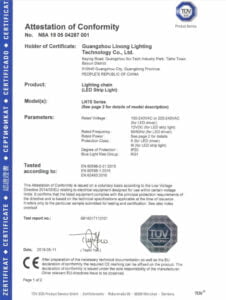



Why Should You Choose Us?
When you choose to LED strips in bulk from us, you’re not just getting a product; you’re gaining a reliable partner dedicated to providing you with top-notch quality, competitive pricing, and unparalleled support.
My Like Led的产品经过各种质量测试,为用户提供高端产品。这里有几个原因,为什么你应该从我们这里得到单色led灯带。
Premium Quality Guaranteed
Our commitment to quality is unwavering. Every single color LED strip that leaves our production line undergoes stringent quality control measures.
Extensive Range of Options
We offer a comprehensive range of single color LED strips with various lengths, brightness levels, and color temperatures. You'll have the flexibility to select the perfect fit for each application.
Competitive Bulk Pricing
By partnering with us for wholesale purchases, you gain access to competitive bulk pricing. Our streamlined manufacturing processes and efficient supply chain management enable us to offer you cost-effective solutions without compromising on quality.
Expertise and Technical Support
Whether you need assistance in selecting the right product or guidance on installation, our technical support team is always ready to help.
Timely Delivery
We understand the importance of timely deliveries in your business operations. With our efficient logistics network, we ensure that your bulk orders are delivered promptly and reliably, keeping your projects on track.
Long-term warranty
We can provide up to 7 years warranty, if there are quality problems, we can provide replacement.
FAQ
Yes, there are waterproof versions of addressable LED strips with IP44, IP65, IP67, and IP68 ratings designed for outdoor use. They are resistant to moisture and environmental elements.
Yes, most addressable LED strips can be cut at designated points without affecting their functionality. However, make sure to follow manufacturer guidelines for cutting and soldering connections.
Yes, many addressable LED strips are compatible with popular smart home platforms like Alexa, Google Assistant, and HomeKit. Integration allows you to control your lighting using voice commands and apps.
Yes, many LED controllers allow you to synchronize multiple strips to create cohesive lighting effects across a larger area.
Yes, there are various protocols such as WS2812, APA102, SK6812, and more. Each protocol has its advantages and compatibility considerations. Check the manufacturer’s specifications for details.
While programming skills can enhance your experience, many LED controllers come with user-friendly software that allows you to create effects without extensive coding knowledge.
Controlling addressable LED strip lights involves using an LED controller or microcontroller to send data and instructions to the individual LEDs on the strip. Here’s how you can control addressable LED strip lights:
Using LED Controller:
Choose an LED Controller: Select an LED controller compatible with your addressable LED strip’s protocol (WS2812, APA102, etc.). Controllers come with various control methods, including remote control, smartphone apps, and physical interfaces.
Connect LED Strip: Follow the manufacturer’s instructions to connect your addressable LED strip to the controller. Ensure proper wiring and polarity.
Power Supply: Connect a suitable power supply to the LED controller to provide power to the LED strip. Make sure the power supply matches the voltage and current requirements of the LED strip.
Control Methods:
- Remote Control: Use the provided remote control to adjust colors, brightness, and effects.
- Smartphone App: Download and install the controller’s smartphone app. Connect the controller to your phone via Wi-Fi or Bluetooth and use the app to control the LED strip.
- Physical Interfaces: Some controllers have buttons, knobs, or touch interfaces for manual control.
Using Microcontroller:
Choose a Microcontroller: Select a microcontroller board like Arduino, Raspberry Pi, or ESP8266 that supports the programming language and protocols of your addressable LED strip.
Connect LED Strip: Wire the data input of the LED strip to the microcontroller’s data output pin. Connect the ground and power pins as well.
Programming: Write or modify a program in the microcontroller’s programming language (e.g., C++ for Arduino, Python for Raspberry Pi) to control the LED strip.
Choose Libraries: Use compatible libraries for your LED strip’s protocol. Install these libraries in your programming environment to simplify communication.
Sending Data: Within your program, use the appropriate functions provided by the libraries to send data and instructions to the LED strip. This can include setting colors, brightness, and effects.
Upload and Run: Upload the program to the microcontroller using the appropriate software and connections. Run the program to see the LED strip respond to your commands.
Using Smart Home Integration:
Choose Smart Home Platform: If your addressable LED strip supports smart home integration, choose a compatible platform like Alexa, Google Assistant, or Apple HomeKit.
Setup: Follow the setup instructions provided by the smart home platform to link your LED controller or microcontroller to your smart home account.
Voice Commands: Once linked, use voice commands like “turn on the LED strip,” “change the color to blue,” or “set brightness to 50%” to control the strip.
App Control: Use the respective smart home app to control the LED strip remotely. Adjust colors, brightness, and effects from the app’s interface.
In summary, controlling addressable LED strip lights involves connecting the strip to an LED controller or microcontroller and sending data or using smart home integration methods to achieve the desired lighting effects, colors, and brightness levels.
Yes, you can dim addressable LED strip lights, but the process is slightly different from dimming traditional analog LED strips. Addressable LED strips offer a high level of control over individual LEDs, allowing you to adjust brightness and create various lighting effects.
Important Notes:
- While dimming addressable LED strips, ensure that the power supply is sufficient to provide the required current at the reduced brightness level.
- Adjusting brightness on addressable LED strips affects the entire strip, as well as any ongoing animations or effects.
- Some protocols may offer limited granularity in brightness adjustments. Experiment to find the desired dimming level.
If you are considering the lighting effects and patterns, the addressable led strips can be categorized into five types: Mono color; Dual color; RGB; RGBW; RGB + Dual color.
Yes, using an addressable LED strip can be safe if proper precautions are taken and manufacturer guidelines are followed. Here are some safety considerations to ensure the safe usage of addressable LED strips:By following these safety precautions and adhering to the manufacturer’s instructions, you can enjoy the benefits of addressable LED strips while minimizing the risk of potential safety hazards. If you’re uncertain about any aspect of installation or usage, consulting a professional electrician or technician can provide additional guidance.
Inspire Creative Lighting With My Like Led!

- Call Us: +86-15920391130
- Email: info@mylikeled.com
- Office Address: No. 4 Keying road, Beitai road, Baiyun district, Guangzhou, China
- Factory: Building 12, Liandong U Valley, Guangqing Industrial Park, Shijiao Town, Qingcheng District, Qingyuan City, Guangdong, China
Copyright © 2025 – My Like Led All rights reserved.

